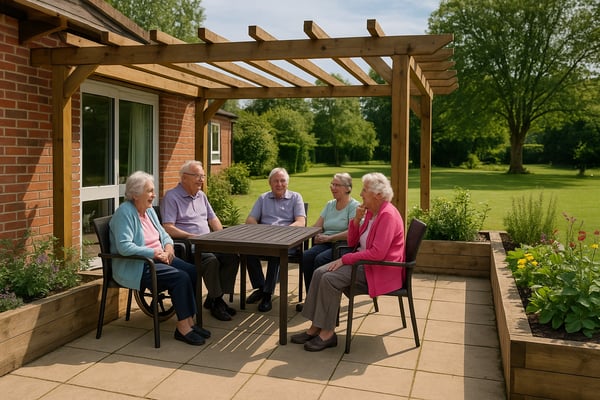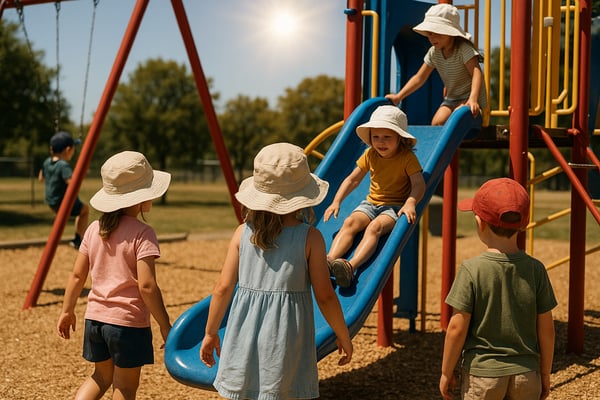How much does a canopy cost?
Here we discuss what factors influence the cost of having permanent, solid-roofed canopies installed, which provide long-term solutions for extending your space outside – whether that’s for classrooms, walkways, dining or play.
We fully understand the constraints on school finances*, and that costs are likely to be a key consideration for our educational and other clients. And we work hard to keep our prices as competitive as possible. Naturally, you’ll want a clear price structure in place before you commit, and you may also want to see if funding via a lottery or charity grant, government scheme or similar may be possible.

What affects canopy prices?
As when buying anything else, a number of factors affect the price you pay for your canopy, including:
Modular or bespoke canopy?
A modular solution works well for most situations, and helps keep costs as low as possible. A genuinely bespoke system will almost certainly set you back more, especially if the structural calculations and safety testing need to be done for a one-off project.
Lighting
Low-energy LED lighting will have minimal impact on energy bills and could mean you get further use of your covered area, for example on winter afternoons. However, it is an extra cost item on your canopy.
Colours
You can have your canopy powder coated in any colour you choose. However, bear in mind that colour matching to any non-standard hue could add up to 15% to your final bill.
You can save money by opting for a standard colour: our Spaceshade canopies come in two standard powder-coated colours, Pure White (RAL 9010) and Anthracite Grey (RAL 7016) which will complement most buildings.

Guarantees
As with anything else, always check the guarantee of your canopy to maximise value for money. All Spaceshade products from Kensington Systems come with a decade-long guarantee as standard, and have a life expectancy of least twenty five years.
Materials used
Canopies made of softwood are likely to be the most inexpensive option, given the simplicity of the design and construction. However, you need to consider the lifetime cost of the canopy; softwood needs constant maintenance, and if it needs replacing in five years you're not getting maximum value for money.
Glued laminated timber (glulam) is increasingly used for canopies in schools. Although it is one of the more expensive materials around, glulam has some significant benefits; it can support very large spans without additional posts, and looks stunning.
Meanwhile, steel is relatively inexpensive and widely available (although, unlike aluminium, it is prone to corrosion). However, steel is extremely heavy and can be difficult to transport – this means a steel canopy needs bigger foundations, and transport and installation costs will be higher due to the equipment required.
Aluminium offers very good value-for-money and is a great choice for most situations: it arrives in modular form, so transport and access costs are kept low, deep foundations aren’t such an issue as with steel owing to its lower weight, and the corrosion-free low-maintenance design means running costs are kept to a minimum.
.jpg?width=1200&length=1200&name=Cleeve%20School%20(8).jpg)
Glazing
Multiwall polycarbonate is strong, lightweight and the cheapest glazing option. Meanwhile, solid polycarbonate and glass cost are both strong and transparent. Solid polycarbonate has an advantage over glass as it is cheaper and more impact-resistant. All three options are certified as non-fragile and safe for schools when used in our Spaceshade system.
Wider may mean cheaper
Along with height, width is important to your canopy spec. You may think two or three metres is wide enough, but rain ingress could leave you with just a metre or two of dry space. Fixtures such as gutters and columns running the length of a canopy cost the same whatever their width. So the wider you go, although the unit cost is slightly more, the square metre price plummets in relative terms.
Solar Panels
Adding solar panels to your canopy is an extra cost, but one that can pay dividends in the long run, saving you thousands of pounds in energy bills and reducing your carbon footprint significantly.
If preferred, you may choose to install the canopy first, and then retrofit the solar panels at a later date when more budget becomes available.
The cost of Kensington Systems canopies
Our actual canopy costs according to area are roughly as follows, including foundations:
- 0-50 sqm – approx. £500-750 per sqm
- 50-100 sqm – approx. £450-550 per sqm
- 100sqm plus – approx. £350-450 per sqm
The costs quoted should be taken as guides only, as each project is different. The overall cost will vary depending on the features you choose, including groundworks needed, side walls, solar panels, lighting and more. For an accurate cost, please get in touch with us directly.
Financing for your school canopy
Kensington Systems have partnered with Tower Leasing to offer operating and finance lease options for schools looking to install a new canopy in a more affordable way. With options for monthly or quarterly payments to suit your needs, Tower Leasing are approved by the Department for Education and already work extensively for schools, helping them finance everything from new IT equipment to minibuses to canopies.
Find out more in our blog or on the Tower Leasing website.
Contact Us
Get in touch with us today. We’re always clear on costs from the outset, and will keep you informed if anything changes. Ask us for a bespoke quote, without charge or obligation for your new school canopy.
*As reported in the Guardian in December 2022 in the wake of the Institute of Fiscal Studies’ (IFS) annual look at education spending, schools in England face a ‘significant squeeze’ on their budgets despite additional government funding. In all, the IFS worked out that spending on education was around 2% less in 2021 than in 2010. Another figure from the think-tank holds that per-pupil funding will be 3% lower in real terms by 2024-25.







